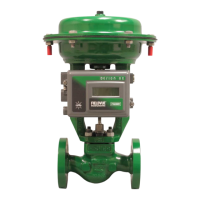Instruction Manual
D103175X012
GX Valve and Actuator
July 2017
13
Packing Adjustment
For ENVIRO-SEAL
™
spring‐loaded single PTFE V‐ring packing (figure 15) or for ENVIRO-SEAL graphite ULF packing
(figure 16), the Belleville spring pack (key 34) maintains a sealing force on the packing. If leakage is detected around
the packing follower (key 29) check to be sure that the packing follower (key 29) is tight. Using a wrench, tighten the
packing follower (key 29) in 1/4 turn intervals until the leakage is stopped. If leakage cannot be stopped in this
manner, proceed to the Replacing Packing section in this manual.
Replacing Packing (Pneumatic Actuators)
This section provides instruction on replacing packing in standard bonnets, extension bonnets, and bellows extension
bonnets.
Isolate the control valve from the line pressure, release pressure from both sides of the valve body and drain the
process media from both sides of the valve. Shut off all pressure lines to the actuator and release all pressure from the
actuator. Use lock‐out procedures to ensure that the above measures stay in effect while you work on the equipment.
1. For air‐to‐open constructions:
a. Connect a separate air supply to the lower diaphragm casing via the air supply connection on the yoke (as shown
in figure 18 or 19) and apply sufficient air pressure to raise the valve plug/stem off the seat to mid travel.
b. Remove the stem connector nut half (key 23), stem connector bolt half (key 24), and travel indicator (key 26).
c. Push the valve plug stem (key 3) down until it contacts the seat.
d. Loosen the locknut (key 28) and thread the stem adjustor nut (key 27) down until it clears the top of the valve
plug stem (key 3).
e. Shut off the air pressure and disconnect the separate air supply to the lower diaphragm casing (as shown in figure
18 or 19).
2. For air‐to‐close constructions, as shown in figure 20 or 21, remove the stem connector nut half (key 23), stem
connector bolt half (key 24), and travel indicator (key 26).
WARNING
To avoid personal injury or property damage by uncontrolled movement of the actuator yoke (key 8), loosen the body/yoke
nuts (figures 18, 19, 20, and 21, key 7) or bonnet/yoke nuts (figures 22 and 23, key 46) by following the instructions in the
next step. Do not remove a stuck actuator yoke by pulling on it with equipment that can stretch or store energy in any other
manner. The sudden release of stored energy can cause uncontrolled movement of the actuator yoke.
Note
The following step also provides additional assurance that the valve body fluid pressure has been relieved.
3. For standard bonnet constructions (figures 18, 19, 20, and 21), body nuts (key 7) attach the actuator yoke (key 8)
to the valve body (key 1). Loosen these nuts approximately 3mm (1/8 inch).
For extension and bellows bonnet constructions, bonnet nuts (key 46) attach the actuator yoke (key 8) to the
extension bonnet (key 39). Loosen these nuts approximately 3mm (1/8 inch).
4. Then loosen the valve‐to‐yoke gasketed joint by either rocking the actuator yoke or prying between the valve and
actuator yoke. Work the prying tool around the actuator yoke until it loosens.

